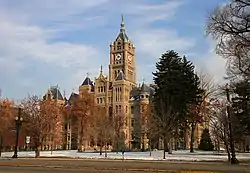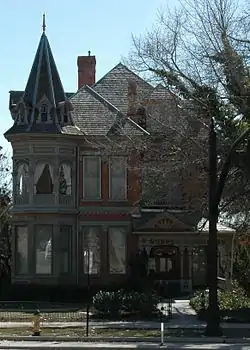Henry Monheim
Henry Monheim (1824—1893)[1] was an American architect who was one of the first "Gentile" (non-Mormon) architects practicing in Salt Lake City, Utah.[2]
Monheim served as the first president of Utah's first professional architectural association, the Salt Lake City Institute of Architects.[2]
He was associated briefly with architects Proudfoot (1860-1928) and Bird (1854-1953) in several works credited to Monheim, Bird & Proudfoot. These works, during just 1892 and 1893, were several buildings in Salt Lake City which provided entree into Salt Lake City for Proudfoot & Bird. Before and after this partnership ended by Monheim's death in 1893, Proudfoot & Bird became much more well-known and was much more influential.[3][4]
Several of Monheim's works are listed on the U.S. National Register of Historic Places (NRHP).[5]
Monheim's works include (with attribution):
- Best-Cannon House, 1146 S. 900 East, Salt Lake City (Monheim, Bird & Proudfoot), NRHP-listed[5]
- Emanuel Kahn House, 678 E. South Temple St., Salt Lake City, (Monheim, Henry), NRHP-listed[5]
- Carriage house (1872) of what is now the Alfred W. McCune Mansion (designed by another architect), 200 N. Main St., Salt Lake City, (Monheim, Henry), NRHP-listed[5]
- Salt Lake City and County Building, 451 Washington Sq., Salt Lake City, (Proudfoot, Bird & Monheim), NRHP-listed[5]
References
- "Henry Monheim, 1824-1893". J. Willard Marriott Library, University of Utah].
- Allen D. Roberts (December 7, 1976). "National Register of Historic Places Inventory/Nomination: Emanuel Kahn House". National Park Service. p. 3. and accompanying photos
- Note: A study of the works of "Proudfoot & Bird, et al." is said to refer to various firms all excluding Monheim's name, specifically it is said to refer "to the combination of architectural firms that were responsible for the firm's work: Proudfoot & Bird, Proudfoot, Bird & Rawson, Proudfoot, Rawson & Souers, Proudfoot, Rawson, Souers & Thomas, and Proudfoot, Rawson, Brooks & Borg."So, Monheim seems not to have been a principal member of the Proudfoot & Bird empire.
- Barbara Beving Long and Ralph J. Christian (November 23, 1988). "Architectural Legacy of Proudfoot & Bird in Iowa MPS".
- "National Register Information System". National Register of Historic Places. National Park Service. July 9, 2010.

